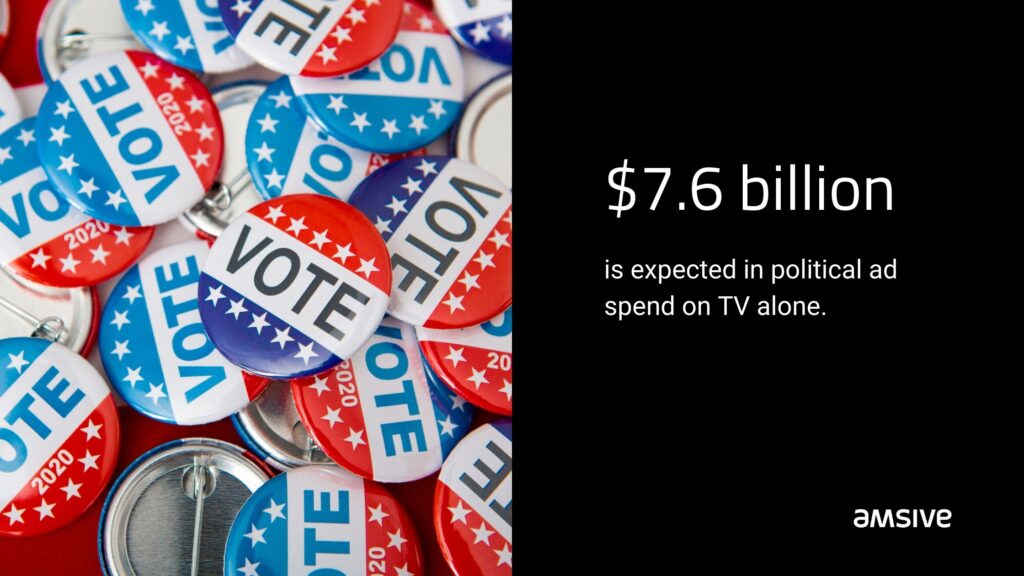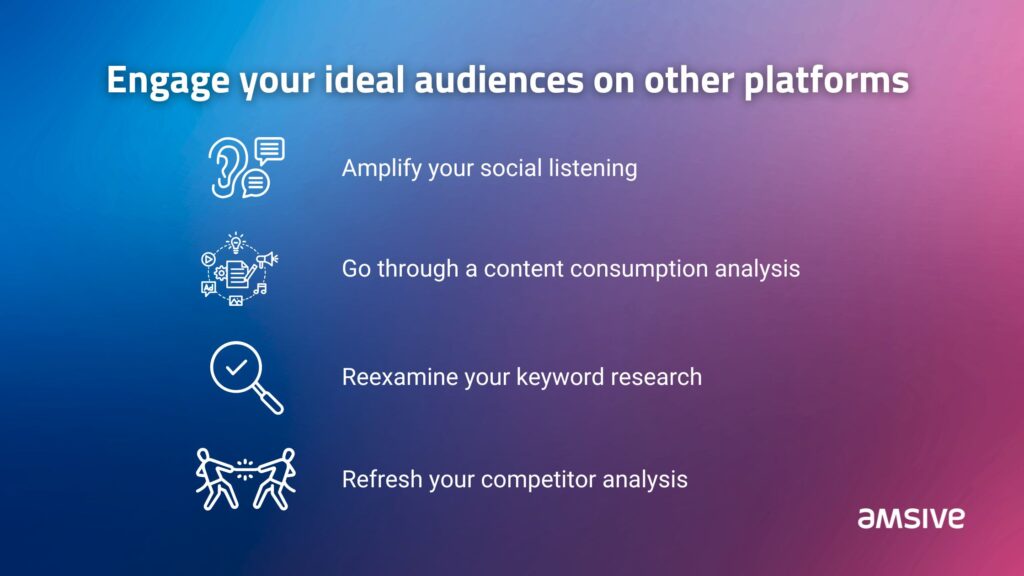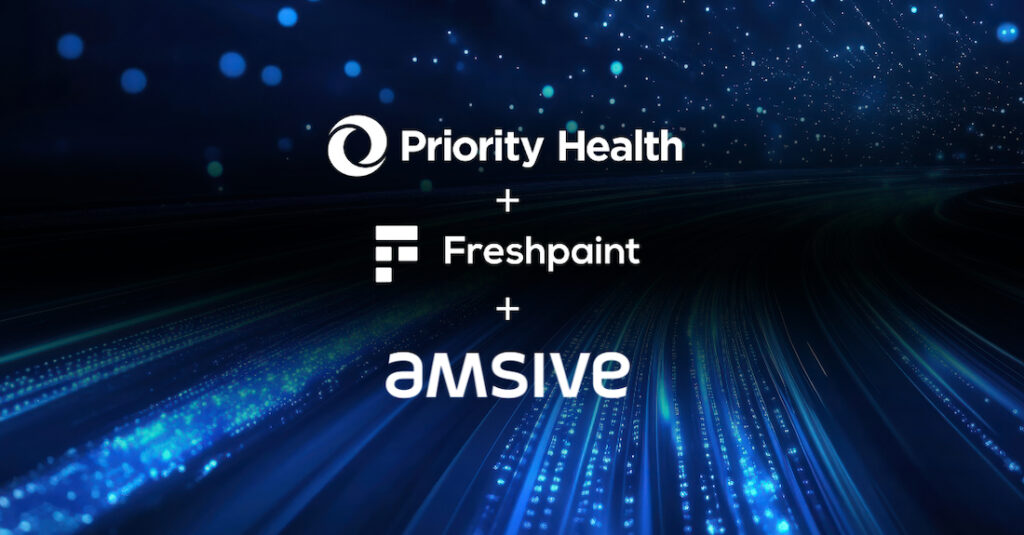As advertising surges during the election year, marketers are facing investment inefficiencies across their multichannel strategies. $12.32 billion is projected to be put toward political ad spend in 2024, spread across TV, CTV, radio, and digital. TV political ad spend alone is expected to reach $7.06 billion. Increased ad competition can mean increased costs and minimized ROAS during periods of high marketing volatility.
Depending on the channel and state, marketers may see a 15-50% increase in Cost Per Clicks. Rate spikes are especially bad throughout the year in key battleground states, and nationally during the core 6 weeks of the election.
We’ll explore how you can tackle visibility concerns, optimize your ad spend and inventory, and improve your multichannel marketing mix to stay visible and control your ROI within a highly competitive landscape.
Jump To:
Solidify your audience segments and explore new platforms
The marketing landscape has already been impacted by this year’s election, and will continue to shift over the next few months. Balancing the channels where your audience is spending the most time and hitting your target KPIs will help you make informed decisions. Costs are soaring with the election cycle’s heightened competition, and businesses need to be judicious to avoid overspending.
Consider what you know about your audience. What channels do they frequent online? Are there digital spaces that you haven’t explored yet?
Dig into the concrete data that you have about your audience. Understanding your existing customers, best audience, and ideal prospects can help you deliver targeted, relevant, and impactful messaging. Prioritize zero- and first-party data from customer interactions, including surveys, social media engagement, and market research.
By understanding your audience’s behavior, you can ensure that you’re outsmarting your competition, especially in a highly competitive ad market.
Beyond budgeting concerns, optimize your messaging for the context and tone of a platform. With not only political ads but political content proliferating platforms, it’s possible that your messaging will be drowned out or ignored when not strategically placed and optimized.
Remember that engaging on a platform that reflects your brand values can keep your audience engaged, as well as reinforce your trust and credibility. Making this strategic alignment can help contribute to overall brand loyalty and build positive associations with that platform’s consumers.
Prioritize programmatic
Programmatic advertising can offer brands and businesses significant advantages in navigating the complex advertising landscape effectively.
Amsive leans on its analytical chops to fine-tune your audience and match your desired consumer profile. Our predictive modeling techniques identify the characteristics that match your best customers, ensuring the highest performance for your campaigns. We apply these analyses to maximize your marketing investment.
Advantages of using programmatic advertising during this election season include:
Targeting precision
Programmatic will let you take full advantage of your zero-, first-, and third-party data, leveraging it to target your ideal audience segments accurately across a wide range of sites and platforms. In a competitive ad market, precise targeting can help you spend efficiently while reaching those most likely to engage with your messaging. Programmatic advertising also has very little waste spend-wise compared to a channel like linear TV. This can become even more important when CPMs and CPCs grow expensive during elections.
You can also lean heavily into contextual and intent targeting to help control spend and maintain return. These capabilities can help you focus ad investment on people who are primed to receive your content and display that content in situations where it will be relevant, rather than displaying where more political noise is likely. Intent and context are always important, but are increasingly so during an election year when people are inundated with ads.
Adaptability and flexibility
Programmatic’s dynamic nature allows campaigns to adapt in real-time based on ad performance and market conditions. As election dynamics evolve and ad costs fluctuate, programmatic platforms, including The Trade Desk, Meta Ads, Google Ads, and Microsoft Ads, can adjust bidding strategies and targeting parameters quickly. This agility is crucial to maximize your spending while responding to the competitive landscape.
Compared to channels like linear TV and radio, where spend is often locked in regardless of what happens, digital-focused platforms like programmatic are far more flexible. If there’s a major conversation or landscape shift during the election, it’s easy to pivot from one channel or platform to another. It also adds a level of budgeting flexibility, allowing you to move spend from one channel to another without pausing all ads.

Avoid ad fatigue
With political campaigns saturating a lot of the traditional ad spaces, programmatic helps diversify where your messaging appears, offering alternatives to your standard strategy. By distributing ads across multiple platforms and formats, including display, video, social and social media, you can lessen the risk of ad fatigue while engaging with your audience throughout the election.
Measurable results and optimization
With metrics such as impressions, clicks, conversions, and engagement tracked in real-time, you can continually optimize and pivot strategy and spend as needed. You can use this information to refine your audience segmentation, optimize your creative, and allocate budgets more effectively based on real-time performance data.
It’s important to remember that programmatic will push your ads to platforms or sites that your users may engage with, but that may not suit your brand values. As you optimize for this channel, consider the contextual keywords and related inventory that you would like to avoid appearing beside.
Stay ahead as brand safety evolves
Conversation around the current political landscape can be intense at its best and polarizing at its worst. As lawmakers and brands consider the impact of misleading content and the increase of AI image misinformation, it’s important that brands reevaluate their brand safety guidelines to mitigate the risk of their ads appearing beside divisive or misleading content.
As streaming platforms, advertising networks, and social media platforms modify the rules of engagement around paid political advertising and the use of AI-generated content, it’s clear that the sites hosting ads are looking toward the potentially destructive nature of bad actors in a regulated environment.
By reassessing your brand safety guidelines, you can mitigate the risk of inadvertently associating your content with harmful or inappropriate material. Consider the content that you’d like to keep your messaging from appearing beside. Reevaluate and fine-tune your negative keyword lists and inventory across display, search, and social.
Keep a close eye on search performance
Candidate-focused topics can disproportionately impact advertisers in specific industries. For example, finance and healthcare are often in the crosshairs, which can cause challenges with paid and organic search performance.
Keep an eye on paid and organic keyword performance and review strategy to adjust where candidates are targeting similar topics. This is another area where optimizing your negative keyword lists can improve ROI and visibility.
You can also minimize or slow spending around necessary business or industry keywords in states where they’re considered hot-button issues. Keeping a closer eye around spend for those keywords can balance ad investment with politically-focused traffic.
Engage your ideal audiences on other platforms
Platforms like Facebook, X, TikTok, and Instagram are expected to see an influx of political messaging and conversation. 64% of social media users believe that it’s one of the easiest places to spread political misinformation.
The channels that are most likely to see the biggest impact in rate spikes due to increased competition are linear TV, CTV/OTT, and radio. Paid search, DOOH, and streaming audio are also impacted, though often to a lesser extent.
Understanding where else your audience is spending their time outside of these high-traffic platforms can help capture their attention in environments where your content or messaging is less likely to be drowned out by political conversation or advertising.
Steps to evaluate other platforms include:
Refresh your competitor analysis
By staying updated on your competitor’s strategies, you can gain crucial insight into evolving trends, shifts in customer behavior, and emerging competitive threats. Consumer attention can be hard to come by, particularly in highly competitive marketing periods, and understanding your competitor’s media placement can help you identify gaps or opportunities in their marketing and targeting tactics.
Reexamine your keyword research
As the election grows closer, certain keywords may become saturated or overly expensive. Refreshing your keyword research will help you identify new, less competitive keywords, or long-tail variations that can still attract qualified traffic for a lower overall ROAS.
Refreshing your keyword research can also help you uncover new opportunities for expansion into niche markets and keep an eye on emerging trends that competitors may have overlooked. This can help you stay ahead of the curve and capitalize on untapped potential in the digital marketing landscape.
Go through a content consumption analysis
Though short-form content still reigns supreme, half of Gen Zers watch immersive, longform content on platforms like TikTok. This is just one of several signals that the way people prefer to consume content is shifting—again.
By updating and analyzing your audience’s preferred forms of content consumption, you can evolve your content strategy. This can help you diversify the types of content that you create and prioritize the most fruitful distribution channels where your audience is the most active and engaged. Tools like BuzzSumo can help you identify popular content formats and platforms that your audience engages with.
Amplify your social listening
Monitor social media platforms and online forums to gauge discussions and sentiments related to your brand, business, or vertical. This can help you identify platforms where conversations are more aligned with your brand’s messaging and less focused on political conversations.
Once you’ve identified platforms that your audience is using, repurpose your content to suit it. Pinterest, for example, is considered a visual search engine. Content like product photos, user-generated unboxing content, or how-to tutorials will excel there.
Other audiences may resonate more deeply with physical advertisements.

Stand out with direct mail
In a climate where the bulk of political ad spend is expected across digital, radio, linear TV, and CTV, you can capture consumer attention in people’s mailboxes. Direct mail offers the opportunity for precise audience targeting and digital channel integration. Sending a tangible piece of mail will set you apart in the digital-centric landscape. People are also more likely to spend more time and pay more attention to direct mail than they are to digital advertising.
Personalizing mailers to include relevant products, promotions, or coupons can help you drive overall engagement. You can also include QR codes or personalized URLs to encourage recipients to engage with relevant digital channels.
Harnessing personalization, tangible results, and digital integration can improve brand visibility and foster a meaningful connection with customers as you stand out above the election chatter, especially in battleground states.
Direct mail provides a great way of cutting through the noise. It gives an extra point of engagement with users who are inundated with political messaging on digital. Direct mail also provides opportunities for special offers and additional messaging that digital ads can’t convey due to how quickly people scan past them (or ignore them altogether due to banner blindness).
For maximum impact, flight deliveries to avoid the week leading up to the caucuses, as well as the two weeks before the election.
Monitor performance to pivot in real time
The fluctuating nature of consumer sentiment and platform use means that brands need to have a responsive approach to their campaigns.
Be prepared to reallocate media spend across channels based on performance insights. If platforms or media channels aren’t delivering expected results, reallocating budget to more effective channels or adjusting targeting parameters can improve campaign performance.
This responsive approach extends to messaging and creative. Be ready to experiment with different messaging, formats, or ad placements to test what resonates with your audience—especially if you’re on channels or platforms that you’re new to.
Outline alternative strategies, and A/B test creative to quickly address challenges or shifts in the competitive landscape. Be extra vigilant when watching for unusual spikes or dips in performance, and be willing to alter strategy or shift budget to other channels.
Consumers vote for your brand with their dollars every day
While these next few months will be challenging for advertisers, there are ways to safeguard against some of the expected marketing volatility. Prioritizing visibility tactics and optimizing your multichannel marketing mixes can help improve your brand presence without negatively impacting your ROAS. Adjusting your strategy to target platforms less likely to be saturated with political messaging can help optimize budgets.
Embracing channels like programmatic can help you remain agile while optimizing your overall reach and ROI. Overall, maintaining flexibility to pivot strategies based on real-time performance and platform shifts will help you come through election season with well-padded pockets.
From programmatic to direct mail, there are many aspects to a winning multichannel marketing mix. Dig into how you can create cross-channel cohesion, or let’s talk about what we can do for your marketing—or your business.







